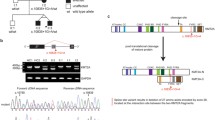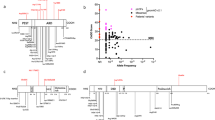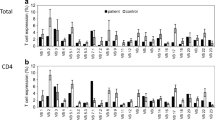Abstract
Genetic diagnostic tools including whole-exome sequencing (WES) have advanced our understanding in human diseases and become common practice in diagnosing patients with suspected primary immune deficiencies. Establishing a genetic diagnosis is of paramount importance for tailoring adequate therapeutic regimens, including identifying the need for hematopoietic stem cell transplantation (HSCT) and genetic-based therapies. Here, we genetically studied two adult patients who were clinically diagnosed during infancy with severe combined immune deficiency (SCID). Two unrelated patients, both of consanguineous kindred, underwent WES in adulthood, 2 decades after their initial clinical manifestations. Upon clinical presentation, immunological workup was performed, which led to a diagnosis of SCID. The patients presented during infancy with failure to thrive, generalized erythematous rash, and recurrent gastrointestinal and respiratory tract infections, including episodes of Pneumocystis pneumonia infection and Candida albicans fungemia. Hypogammaglobulinemia and T-cell lymphopenia were detected. Both patients were treated with a 10/10 HLA matched sibling donor unconditioned HSCT. Retrospective genetic workup revealed homozygous bi-allelic mutations in IL7RA in one patient and in RAG2 in the other. Our study exemplifies the impact of retrospectively establishing a genetic diagnosis. Pinpointing the genetic cause raises several issues including optimized surveillance and treatment, understanding disease mechanisms and outcomes, future family planning, and social and psychological considerations.

Similar content being viewed by others
References
Fischer A. Human primary immunodeficiency diseases: a perspective. Nat Immunol. 2004;1:23–30.
Seleman M, Hoyos-Bachiloglu R, Geha RS, Chou J. Uses of next-generation sequencing technologies for the diagnosis of primary immunodeficiencies. Front Immunol. 2017;8:847.
Notarangelo LD. Primary immunodeficiencies. J Allergy Clin Immunol. 2010;125(2 Suppl 2):S182–S94.
Kostmann R. Infantile genetic agranulocytosis (Agranulocystosis infantilis hereditaria): a new recessive lethal disease in man. Acta Paediatr. 1956;45(Suppl):1–78.
Klein C, Grudzien M, Appaswamy G, Germeshausen M, Sandrock I, Schäffer AA, et al. HAX1 deficiency causes autosomal recessive severe congenital neutropenia (Kostmann disease). Nat Genet. 2007;39(1):86–92.
Wiskott A. Familiärer, angeborener Morbus Werlhofii? Monatsschr Kinderheilkd. 1937;68:212–6.
Aldrich RA, Steinberg AG, Campbell DC. Pedigree demonstrating a sex-linked recessive condition characterized by draining ears, eczematoid dermatitis and bloody diarrhea. Pediatrics. 1954;13:133–9.
Ochs HD, Rosen FS. The Wiskott Aldrich syndrome. In: Ochs HD, Smith CIE, Puck JM, editors. Primary immunodeficiency diseases: a molecular and genetic approach. New York: Oxford University Press; 1999. p. 292–305.
Thrasher AJ, Kinnon C. The Wiskott-Aldrich syndrome. Clin Exp Immunol. 2000;120:2–9.
Binder V, Albert MH, Kabus M, Bertone M, Meindl A, Belohradsky BH. The genotype of the original Wiskott phenotype. N Engl J Med. 2006;355(17):1790–3.
Mahlaoui N, Warnatz K, Jones A, Workman S, Cant A. Advances in the Care of Primary Immunodeficiencies (PIDs): from Birth to Adulthood. J Clin Immunol. 2017;37(5):452–60. https://doi.org/10.1007/s10875-017-0401-y.
Kwan A, Abraham RS, Currier R, et al. Newborn screening for severe combined immunodeficiency in 11 screening programs in the United States. JAMA. 2014;312(7):729–38.13. Broides A,.
Nahum A, Mandola AB, et al. Incidence of typically severe primary immunodeficiency diseases in consanguineous and non-consanguineous populations. J Clin Immunol. 2017;37:295–300.
Lev A, Simon AJ, Broides A, Levi J, Garty BZ, Rosenthal E, et al. Thymic function in MHC class II-deficient patients. J Allergy Clin Immunol. 2013;131(3):831–9.
Gomez CA, Ptaszek LM, Villa A, Bozzi F, Sobacchi C, Brooks EG, et al. Mutations in conserved regions of the predicted RAG2 kelch repeats block initiation of V(D)J recombination and result in primary immunodeficiencies. Mol Cell Biol. 2000;20(15):5653–64.
Tabori U, Mark Z, Amariglio N, Etzioni A, Golan H, Biloray B, et al. Detection of RAG mutations and prenatal diagnosis in families presenting with either T-B- severe combined immunodeficiency or Omenn’s syndrome. Clin Genet. 2004;65(4):322–6.
Meshaal SS, El Hawary RE, Abd Elaziz DS, et al. Phenotypical heterogeneity in RAG-deficient patients from a highly consanguineous population. Clin Exp Immunol. 2019;195(2):202–12.
Tirosh I, Yamazaki Y, Frugoni F, Ververs FA, Allenspach EJ, Zhang Y, et al. Recombination activity of human recombination-activating gene 2 (RAG2) mutations and correlation with clinical phenotype. J Allergy Clin Immunol. 2019;143(2):726–35.
Greenberg-Kushnir N, Lee YN, Simon AJ, Lev A, Marcus N, Abuzaitoun O, et al. A large cohort of RAG1/2-deficient SCID patients-clinical, immunological, and prognostic analysis. J Clin Immunol. 2020;40(1):211–22.
Simon AJ, Golan AC, Lev A, Stauber T, Barel O, Somekh I, et al. Whole exome sequencing (WES) approach for diagnosing primary immunodeficiencies (PIDs) in a highly consanguineous community. Clin Immunol. 2020;214:108376.
Somech R. T-cell receptor excision circles in primary immunodeficiencies and other T-cell immune disorders. Curr Opin Allergy Clin Immunol. 2011;11(6):517–24.
Buckley RH, Schiff SE, Schiff RI, Markert ML, Williams LW, Roberts JL, et al. Hematopoietic stem-cell transplantation for the treatment of severe combined immunodeficiency. N Engl J Med. 1999;340(7):508–16.
Antoine C, Müller S, Cant A, Cavazzana-Calvo M, Veys P, Vossen J, et al. Long-term survival and transplantation of haemopoietic stem cells for immunodeficiencies: report of the European experience 1968-99. Lancet. 2003;361:553–60.
Puel A, Ziegler SF, Buckley RH, et al. Defective IL7R expression in T(-)B(+)NK(+) severe combined immunodeficiency. Nat Genet. 1998;4:394–7.
Zago CA, Jacob CM, de Albuquerque Diniz EM, et al. Autoimmune manifestations in SCID due to IL7R mutations: Omenn syndrome and cytopenias. Hum Immunol. 2014;7:662–6.
Schwarz K, Gauss GH, Ludwig L, Pannicke U, Li Z, Lindner D, et al. RAG mutations in human B cell-negative SCID. Science. 1996;274:97–9.
Villa A, Santagata S, Bozzi F, Imberti L, Notarangelo LD. Omenn syndrome: a disorder of Rag1 and Rag2 genes. J Clin Immunol. 1999;19(2):87–97. https://doi.org/10.1023/a:1020550432126.
Cavazzana-Calvo M, Carlier F, Le Deist F, et al. Long-term T-cell reconstitution after hematopoietic stem-cell transplantation in primary T-cell-immunodeficient patients is associated with myeloid chimerism and possibly the primary disease phenotype. Blood. 2007;109:4575–81.
Borghans JA, Bredius RG, Hazenberg MD, et al. Early determinants of long-term T-cell reconstitution after hematopoietic stem cell transplantation for severe combined immunodeficiency. Blood. 2006;108:763–9. https://doi.org/10.1182/blood-2006-01-009241.
Gennery AR, Lankester A. Long term outcome and immune function after hematopoietic stem cell transplantation for primary immunodeficiency. Front Pediatr. 2019;7:381.
Schuetz C, Neven B, Dvorak CC, Leroy S, Ege MJ, Pannicke U, et al. SCID patients with ARTEMIS vs RAG deficiencies following HCT: increased risk of late toxicity in ARTEMIS-deficient SCID [published correction appears in Blood. 2018 Dec 6;132(23):2527]. Blood. 2014;123:281–9.
Haddad E, Logan BR, Griffith LM, Buckley RH, Parrott RE, Prockop SE, et al. SCID genotype and 6-month posttransplant CD4 count predict survival and immune recovery. Blood. 2018;132:1737–49.
Hönig M, Albert MH, Schulz A, et al. Patients with adenosine deaminase deficiency surviving after hematopoietic stem cell transplantation are at high risk of CNS complications. Blood. 2007;109:3595–602.
Titman P, Pink E, Skucek E, O'Hanlon K, Cole TJ, Gaspar J, et al. Cognitive and behavioral abnormalities in children after hematopoietic stem cell transplantation for severe congenital immunodeficiencies. Blood. 2008;112:3907–13.
Tangye SG, Al-Herz W, Bousfiha A, et al. Human inborn errors of immunity: 2019 update on the classification from the International Union of Immunological Societies Expert Committee. J Clin Immunol. 2020;40:24–64.
Rechavi E, Lev A, Simon AJ, Stauber T, Daas S, Saraf-Levy T, et al. First year of Israeli newborn screening for severe combined immunodeficiency-clinical achievements and insights. Front Immunol. 2017;8:1448.
Blaese RM, Culver KW, Miller AD, Carter CS, Fleisher T, Clerici M, et al. T lymphocyte directed gene therapy for ADA-SCID: initial trial results after 4 years. Science. 1995;270:475–80.
Mamcarz E, Zhou S, Lockey T, Abdelsamed H, Cross SJ, Kang G, et al. Lentiviral gene therapy combined with low-dose busulfan in infants with SCID-X1. N Engl J Med. 2019;380:1525–34.
Kuo CY, Kohn DB. Gene therapy for the treatment of primary immune deficiencies. Curr Allergy Asthma Rep. 2016;16:39. https://doi.org/10.1007/s11882-016-0615-8.
Notarangelo LD, Fleisher TA. Targeted strategies directed at the molecular defect: toward precision medicine for select primary immunodeficiency disorders. J Allergy Clin Immunol. 2017;139:715–23.
Angulo I, Vadas O, Garcon F, Banham-Hall E, Plagnol V, Leahy TR, et al. Phosphoinositide 3-kinase delta gene mutation predisposes to respiratory infection and airway damage. Science. 2013;342:866–71.
Lucas CL, Kuehn HS, Zhao F, Niemela JE, Deenick EK, Palendira U, et al. Dominant-activating germline mutations in the gene encoding the PI(3)K catalytic subunit p110delta result in T cell senescence and human immunodeficiency. Nat Immunol. 2014;15:88–97.
Lucas CL, Zhang Y, Venida A, Wang Y, Hughes J, McElwee J, et al. Heterozygous splice mutation in PIK3R1 causes human immunodeficiency with lymphoproliferation due to dominant activation of PI3K. J Exp Med. 2014;211:2537–47.
Alosaimi M, Hoenig M, Jaber F, et al. Immunodeficiency and EBV induced lymphoproliferation caused by 4-1BB deficiency. J Allergy Clin Immunol. 2019;144:574–583.e5.
Somekh I, Thian M, Medgyesi D, Gülez N, Magg T, Gallón Duque A, et al. CD137 deficiency causes immune dysregulation with predisposition to lymphomagenesis. Blood. 2019;134:1510–6.
Rodriguez R, Fournier B, Cordeiro DJ, Winter S, Izawa K, Martin E, et al. Concomitant PIK3CD and TNFRSF9 deficiencies cause chronic active Epstein-Barr virus infection of T cells. J Exp Med. 2019;216:2800–18.
Sznol M, Hodi FS, Margolin K, et al. Phase I study of BMS-663513, a fully human anti-CD137 agonist monoclonal antibody, in patients (pts) with advanced cancer (CA) [abstract]. J Clin Oncol. 2008;26(suppl 15):Abstract 3007.
Segal NH, Gopal AK, Bhatia S, et al. A phase 1 study of PF-05082566 (anti-4-1BB) in patients with advanced cancer [abstract]. J Clin Oncol. 2014;32(suppl 15):Abstract 3007.
Lee S, Moon JS, Lee CR, Kim HE, Baek SM, Hwang S, et al. Abatacept alleviates severe autoimmune symptoms in a patient carrying a de novo variant in CTLA-4. J Allergy Clin Immunol. 2016;137:327–30.
Herrero-Beaumont G, Martínez Calatrava MJ, Castañeda S. Abatacept mechanism of action: concordance with its clinical profile. Reumatol Clin. 2012;8:78–83.
Rapamune Prescribing Information" (PDF). United States Food and Drug Administration. Wyeth Pharmaceuticals, Inc. May 2015. Retrieved 28 May 2016.
Acknowledgements
We thank the families for participating in this study. We thank the Jeffrey Modell Foundation, Israel Ministry of Health, and the Israeli Science Foundation for their financial support. Prof. Raz Somech, Dr. Ayal Hendel, and Dr. Yu nee Lee gratefully acknowledge the funding support from the Israeli Science Foundation (ISF) under the Israel Precision Medicine Program (IPMP), grant agreement No. 3115/19.
Author information
Authors and Affiliations
Contributions
I.S. and R.S. conceptualized the designed study and drafted the manuscript which was reviewed and approved by all authors. R.S. treated the patients studied. A.L., A.H., Y.N.L., and A.J.S. performed and analyzed immune and genetic experiments. O.B. analyzed WES data.
Corresponding author
Ethics declarations
Conflict of interest
The authors declare no competing interests.
Additional information
Publisher’s note
Springer Nature remains neutral with regard to jurisdictional claims in published maps and institutional affiliations.
Rights and permissions
About this article
Cite this article
Somekh, I., Lev, A., Barel, O. et al. Exploring genetic defects in adults who were clinically diagnosed as severe combined immune deficiency during infancy. Immunol Res 69, 145–152 (2021). https://doi.org/10.1007/s12026-021-09179-3
Received:
Accepted:
Published:
Issue Date:
DOI: https://doi.org/10.1007/s12026-021-09179-3




